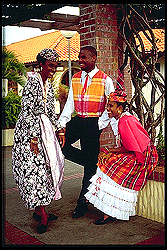
The Culture & People of St. Lucia
St. Lucia's culture has evolved from the intermingling of the many different groups of people who have participated in its history. Each has brought different beliefs and traditions, all of which are reflected in the life of the island today. A visitor is likely to drive on the British side of the road to an Indian restaurant in a French town, greeted all along the way in Creole patois.

One of the most accessible expressions of St. Lucia's rich cultural heritage is its cuisine. The fertile, volcanic soil of the island yields an enormous supply of produce, and the island is one of the leading banana exporters in the Caribbean, with six different varieties available. In addition to bananas, St. Lucia's abundant tropical fruits include mangoes, papayas, pineapples, soursops, passionfruit, guavas, and coconuts. Local chefs combine the island's fresh produce with a wide variety of equally fresh seafood to create tantalizing curries, Creole-style entrees, and pepperpot stews. Callaloo soup, made from a leafy green similar to spinach, is the national dish. The island's outstanding cuisine has recently gained international recognition by garnering several gold medals in the regions most prestigious culinary competitions.
But St. Lucia's culture extends far beyond the table, as the island has long held a reputation for its intellectual and artistic talents. St. Lucia has produced two Nobel Prizewinners: the late Sir W. Arthur Lewis, who won the Nobel Prize for Economics in 1979, and poet Derek Walcott, who won the 1992 Nobel Prize for Literature.
To understand as well as enjoy St. Lucia's culture is largely a matter of gaining some sense of the various peoples who have contributed to it. The first of these were the Arawaks and the Caribs, Amerindian peoples indigenous to the entire Caribbean. They were expert hunters, farmers, fishermen, and skilled artists. Their primary crops were cassava, yams, sweet potatoes, all of which still play a central role in the island's food. The Amerindians were decimated by the arrival of the Europeans, and only a small number of St. Lucians can still trace their roots back to this group. Some of the few particular aspects of Amerindian culture that survive include farina and cassava bread, fish-pots and other local craft items. Some villages still practice the ancient art of fishing in dug-out canoes.
The next group to arrive on the shores of the island were the Europeans, primarily the British and the French. Though the Europeans didn't settle St. Lucia in large numbers, they had an incalculable impact on the island's history and culture. The British and French influences seem to weigh equally, despite the fact that the French lost the island in 1814. To St. Lucia's complex cultural mosaic, the British contributed their language, educational system, and legal and political structure. French culture is more evident in the arts--music, dance, and Creole patois, which stands alongside the official language of English.
At the same time that the Europeans were bringing their own cultures to St. Lucia, African culture was becoming established through the arrival of slaves for European plantations and, later, indentured labourers. Their descendants constitute the largest percentage of the island's population, and their proud heritage has had an enormous impact on St. Lucia's character as a nation. African traditions have survived the repressions of slavery and servitude to become the strongest element in St. Lucian culture today.
After the abolition of slavery, East Indians came to St. Lucia as indentured servants. Most worked in the large sugar factories in the Cul-de-Sac, Roseau, and Mabouya valleys and in Vieux Fort, where there is still a significant East Indian community. In comparison to other immigrant groups, their numbers were small. Although their traditional culture has almost disappeared, the East Indians have had a notable and lasting influence on the island's fine cuisine.
This page, and all contents of this web site are Copyright (c) 1996-2015 by interKnowledge Corp., New York, NY. All rights reserved.